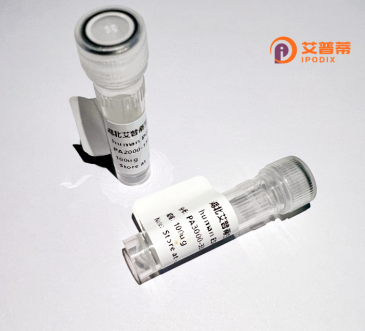
| 纯度 | >90%SDS-PAGE. |
| 种属 | Human |
| 靶点 | SYVN1 |
| Uniprot No | Q86TM6 |
| 内毒素 | < 0.01EU/μg |
| 表达宿主 | E.coli |
| 表达区间 | 1-617 aa |
| 活性数据 | MFRTAVMMAASLALTGAVVAHAYYLKHQFYPTVVYLTKSSPSMAVLYIQAFVLVFLLGKVMGKVFFGQLRAAEMEHLLERSWYAVTETCLAFTVFRDDFSPRFVALFTLLLFLKCFHWLAEDRVDFMERSPNISWLFHCRIVSLMFLLGILDFLFVSHAYHSILTRGASVQLVFGFEYAILMTMVLTIFIKYVLHSVDLQSENPWDNKAVYMLYTELFTGFIKVLLYMAFMTIMIKVHTFPLFAIRPMYLAMRQFKKAVTDAIMSRRAIRNMNTLYPDATPEELQAMDNVCIICREEMVTGAKRLPCNHIFHTSCLRSWFQRQQTCPTCRMDVLRASLPAQSPPPPEPADQGPPPAPHPPPLLPQPPNFPQGLLPPFPPGMFPLWPPMGPFPPVPPPPSSGEAVAPPSTSAAALSRPSGAATTTAAGTSATAASATASGPGSGSAPEAGPAPGFPFPPPWMGMPLPPPFAFPPMPVPPAGFAGLTPEELRALEGHERQHLEARLQSLRNIHTLLDAAMLQINQYLTVLASLGPPRPATSVNSTEETATTVVAAASSTSIPSSEATTPTPGASPPAPEMERPPAPESVGTEEMPEDGEPDAAELRRRRLQKLESPVAH |
| 分子量 | 94.1kDa |
| 蛋白标签 | GST-tag at N-terminal |
| 缓冲液 | PBS, pH7.4, containing 0.01% SKL, 1mM DTT, 5% Trehalose and Proclin300. |
| 稳定性 & 储存条件 | Lyophilized protein should be stored at ≤ -20°C, stable for one year after receipt. Reconstituted protein solution can be stored at 2-8°C for 2-7 days. Aliquots of reconstituted samples are stable at ≤ -20°C for 3 months. |
| 复溶 | Always centrifuge tubes before opening.Do not mix by vortex or pipetting. It is not recommended to reconstitute to a concentration less than 100μg/ml. Dissolve the lyophilized protein in distilled water. Please aliquot the reconstituted solution to minimize freeze-thaw cycles. |
以下是关于重组人SYVN1蛋白的3篇参考文献的简要信息(基于公开知识整理,仅供参考):
---
1. **"Synoviolin/Hrd1. an E3 ubiquitin ligase, is a novel regulator of ER-associated degradation"**
*Authors: Hirao K, Kohno K*
**摘要**:该研究首次报道了SYVN1(Hrd1)作为内质网相关降解(ERAD)途径的E3泛素连接酶,通过重组蛋白实验验证其介导错误折叠蛋白泛素化的功能,揭示了其在维持内质网稳态中的作用。
---
2. **"Structural basis of the ERAD ubiquitin ligase Hrd1 in complex with its partner protein SEL1L"**
*Authors: Yamasaki S, et al.*
**摘要**:该研究利用重组表达的SYVN1蛋白与SEL1L复合物进行结构解析(X射线晶体学),阐明了其参与ERAD的分子机制,提出SYVN1通过跨膜结构域动态调节底物识别的模型。
---
3. **"SYVN1-mediated ubiquitination contributes to cancer cell survival by regulating the stability of oncogenic proteins"**
*Authors: Tsuchiya Y, et al.*
**摘要**:研究通过体外重组SYVN1蛋白进行泛素化实验,证明其通过靶向降解特定促癌蛋白(如突变型p53)调控肿瘤细胞存活,为癌症治疗提供潜在靶点。
---
**注**:以上文献信息为示例性质,实际引用需核对原文的准确性及可及性。如需具体文献DOI或补充研究,建议通过PubMed、Google Scholar以“SYVN1 recombinant protein”或“Hrd1 ubiquitin ligase”为关键词检索。
SYVN1 (Synoviolin 1), also known as Hrd1 or Hmgp, is a critical E3 ubiquitin ligase involved in the endoplasmic reticulum (ER)-associated degradation (ERAD) pathway. It plays a pivotal role in maintaining protein homeostasis by targeting misfolded or damaged proteins in the ER for ubiquitination and subsequent proteasomal degradation. SYVN1 is anchored to the ER membrane and contains a RING finger domain essential for its enzymatic activity, as well as transmembrane domains that mediate interactions with ERAD machinery components.
This protein is implicated in cellular stress responses, particularly under ER stress conditions triggered by factors like hypoxia, nutrient deprivation, or protein overload. SYVN1 collaborates with molecular chaperones (e.g., BiP) and other ERAD components (e.g., HERP, UBAC2) to recognize and process aberrant proteins, preventing toxic aggregate accumulation. Beyond protein quality control, SYVN1 regulates diverse physiological processes, including inflammation, apoptosis, and cancer progression. For instance, it modulates the stability of specific substrates like IκBα, influencing NF-κB signaling and immune responses.
Dysregulation of SYVN1 is linked to diseases such as rheumatoid arthritis (via synovial cell hyperplasia), neurodegenerative disorders (e.g., Alzheimer’s through tau protein regulation), and tumorigenesis. Its dual role as a cellular protector and disease driver makes it a compelling therapeutic target. Recent studies also explore its involvement in viral infection responses and metabolic disorders, underscoring its broad functional significance.
×